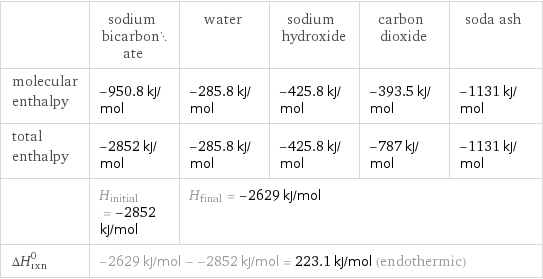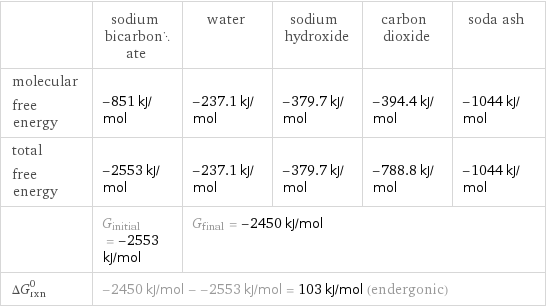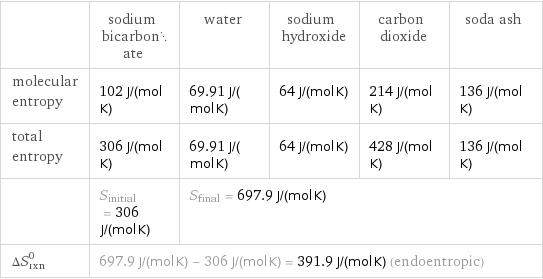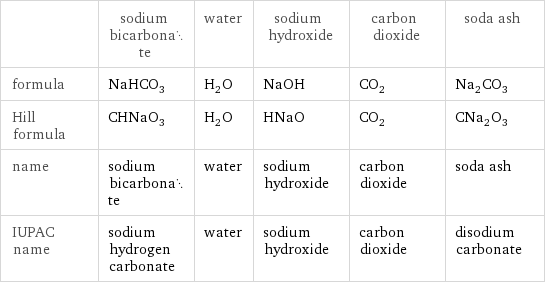Input interpretation

NaHCO_3 sodium bicarbonate ⟶ H_2O water + NaOH sodium hydroxide + CO_2 carbon dioxide + Na_2CO_3 soda ash
Balanced equation

Balance the chemical equation algebraically: NaHCO_3 ⟶ H_2O + NaOH + CO_2 + Na_2CO_3 Add stoichiometric coefficients, c_i, to the reactants and products: c_1 NaHCO_3 ⟶ c_2 H_2O + c_3 NaOH + c_4 CO_2 + c_5 Na_2CO_3 Set the number of atoms in the reactants equal to the number of atoms in the products for C, H, Na and O: C: | c_1 = c_4 + c_5 H: | c_1 = 2 c_2 + c_3 Na: | c_1 = c_3 + 2 c_5 O: | 3 c_1 = c_2 + c_3 + 2 c_4 + 3 c_5 Since the coefficients are relative quantities and underdetermined, choose a coefficient to set arbitrarily. To keep the coefficients small, the arbitrary value is ordinarily one. For instance, set c_2 = 1 and solve the system of equations for the remaining coefficients: c_2 = 1 c_3 = c_1 - 2 c_4 = c_1 - 1 c_5 = 1 The resulting system of equations is still underdetermined, so an additional coefficient must be set arbitrarily. Set c_1 = 3 and solve for the remaining coefficients: c_1 = 3 c_2 = 1 c_3 = 1 c_4 = 2 c_5 = 1 Substitute the coefficients into the chemical reaction to obtain the balanced equation: Answer: | | 3 NaHCO_3 ⟶ H_2O + NaOH + 2 CO_2 + Na_2CO_3
Structures

⟶ + + +
Names

sodium bicarbonate ⟶ water + sodium hydroxide + carbon dioxide + soda ash
Reaction thermodynamics
Enthalpy

| sodium bicarbonate | water | sodium hydroxide | carbon dioxide | soda ash molecular enthalpy | -950.8 kJ/mol | -285.8 kJ/mol | -425.8 kJ/mol | -393.5 kJ/mol | -1131 kJ/mol total enthalpy | -2852 kJ/mol | -285.8 kJ/mol | -425.8 kJ/mol | -787 kJ/mol | -1131 kJ/mol | H_initial = -2852 kJ/mol | H_final = -2629 kJ/mol | | | ΔH_rxn^0 | -2629 kJ/mol - -2852 kJ/mol = 223.1 kJ/mol (endothermic) | | | |
Gibbs free energy

| sodium bicarbonate | water | sodium hydroxide | carbon dioxide | soda ash molecular free energy | -851 kJ/mol | -237.1 kJ/mol | -379.7 kJ/mol | -394.4 kJ/mol | -1044 kJ/mol total free energy | -2553 kJ/mol | -237.1 kJ/mol | -379.7 kJ/mol | -788.8 kJ/mol | -1044 kJ/mol | G_initial = -2553 kJ/mol | G_final = -2450 kJ/mol | | | ΔG_rxn^0 | -2450 kJ/mol - -2553 kJ/mol = 103 kJ/mol (endergonic) | | | |
Entropy

| sodium bicarbonate | water | sodium hydroxide | carbon dioxide | soda ash molecular entropy | 102 J/(mol K) | 69.91 J/(mol K) | 64 J/(mol K) | 214 J/(mol K) | 136 J/(mol K) total entropy | 306 J/(mol K) | 69.91 J/(mol K) | 64 J/(mol K) | 428 J/(mol K) | 136 J/(mol K) | S_initial = 306 J/(mol K) | S_final = 697.9 J/(mol K) | | | ΔS_rxn^0 | 697.9 J/(mol K) - 306 J/(mol K) = 391.9 J/(mol K) (endoentropic) | | | |
Equilibrium constant
![Construct the equilibrium constant, K, expression for: NaHCO_3 ⟶ H_2O + NaOH + CO_2 + Na_2CO_3 Plan: • Balance the chemical equation. • Determine the stoichiometric numbers. • Assemble the activity expression for each chemical species. • Use the activity expressions to build the equilibrium constant expression. Write the balanced chemical equation: 3 NaHCO_3 ⟶ H_2O + NaOH + 2 CO_2 + Na_2CO_3 Assign stoichiometric numbers, ν_i, using the stoichiometric coefficients, c_i, from the balanced chemical equation in the following manner: ν_i = -c_i for reactants and ν_i = c_i for products: chemical species | c_i | ν_i NaHCO_3 | 3 | -3 H_2O | 1 | 1 NaOH | 1 | 1 CO_2 | 2 | 2 Na_2CO_3 | 1 | 1 Assemble the activity expressions accounting for the state of matter and ν_i: chemical species | c_i | ν_i | activity expression NaHCO_3 | 3 | -3 | ([NaHCO3])^(-3) H_2O | 1 | 1 | [H2O] NaOH | 1 | 1 | [NaOH] CO_2 | 2 | 2 | ([CO2])^2 Na_2CO_3 | 1 | 1 | [Na2CO3] The equilibrium constant symbol in the concentration basis is: K_c Mulitply the activity expressions to arrive at the K_c expression: Answer: | | K_c = ([NaHCO3])^(-3) [H2O] [NaOH] ([CO2])^2 [Na2CO3] = ([H2O] [NaOH] ([CO2])^2 [Na2CO3])/([NaHCO3])^3](../image_source/0130ad65f86dcc7ba4e181a06f36727e.png)
Construct the equilibrium constant, K, expression for: NaHCO_3 ⟶ H_2O + NaOH + CO_2 + Na_2CO_3 Plan: • Balance the chemical equation. • Determine the stoichiometric numbers. • Assemble the activity expression for each chemical species. • Use the activity expressions to build the equilibrium constant expression. Write the balanced chemical equation: 3 NaHCO_3 ⟶ H_2O + NaOH + 2 CO_2 + Na_2CO_3 Assign stoichiometric numbers, ν_i, using the stoichiometric coefficients, c_i, from the balanced chemical equation in the following manner: ν_i = -c_i for reactants and ν_i = c_i for products: chemical species | c_i | ν_i NaHCO_3 | 3 | -3 H_2O | 1 | 1 NaOH | 1 | 1 CO_2 | 2 | 2 Na_2CO_3 | 1 | 1 Assemble the activity expressions accounting for the state of matter and ν_i: chemical species | c_i | ν_i | activity expression NaHCO_3 | 3 | -3 | ([NaHCO3])^(-3) H_2O | 1 | 1 | [H2O] NaOH | 1 | 1 | [NaOH] CO_2 | 2 | 2 | ([CO2])^2 Na_2CO_3 | 1 | 1 | [Na2CO3] The equilibrium constant symbol in the concentration basis is: K_c Mulitply the activity expressions to arrive at the K_c expression: Answer: | | K_c = ([NaHCO3])^(-3) [H2O] [NaOH] ([CO2])^2 [Na2CO3] = ([H2O] [NaOH] ([CO2])^2 [Na2CO3])/([NaHCO3])^3
Rate of reaction
![Construct the rate of reaction expression for: NaHCO_3 ⟶ H_2O + NaOH + CO_2 + Na_2CO_3 Plan: • Balance the chemical equation. • Determine the stoichiometric numbers. • Assemble the rate term for each chemical species. • Write the rate of reaction expression. Write the balanced chemical equation: 3 NaHCO_3 ⟶ H_2O + NaOH + 2 CO_2 + Na_2CO_3 Assign stoichiometric numbers, ν_i, using the stoichiometric coefficients, c_i, from the balanced chemical equation in the following manner: ν_i = -c_i for reactants and ν_i = c_i for products: chemical species | c_i | ν_i NaHCO_3 | 3 | -3 H_2O | 1 | 1 NaOH | 1 | 1 CO_2 | 2 | 2 Na_2CO_3 | 1 | 1 The rate term for each chemical species, B_i, is 1/ν_i(Δ[B_i])/(Δt) where [B_i] is the amount concentration and t is time: chemical species | c_i | ν_i | rate term NaHCO_3 | 3 | -3 | -1/3 (Δ[NaHCO3])/(Δt) H_2O | 1 | 1 | (Δ[H2O])/(Δt) NaOH | 1 | 1 | (Δ[NaOH])/(Δt) CO_2 | 2 | 2 | 1/2 (Δ[CO2])/(Δt) Na_2CO_3 | 1 | 1 | (Δ[Na2CO3])/(Δt) (for infinitesimal rate of change, replace Δ with d) Set the rate terms equal to each other to arrive at the rate expression: Answer: | | rate = -1/3 (Δ[NaHCO3])/(Δt) = (Δ[H2O])/(Δt) = (Δ[NaOH])/(Δt) = 1/2 (Δ[CO2])/(Δt) = (Δ[Na2CO3])/(Δt) (assuming constant volume and no accumulation of intermediates or side products)](../image_source/7fa3a2fe80a9fc662b49586908ac69f1.png)
Construct the rate of reaction expression for: NaHCO_3 ⟶ H_2O + NaOH + CO_2 + Na_2CO_3 Plan: • Balance the chemical equation. • Determine the stoichiometric numbers. • Assemble the rate term for each chemical species. • Write the rate of reaction expression. Write the balanced chemical equation: 3 NaHCO_3 ⟶ H_2O + NaOH + 2 CO_2 + Na_2CO_3 Assign stoichiometric numbers, ν_i, using the stoichiometric coefficients, c_i, from the balanced chemical equation in the following manner: ν_i = -c_i for reactants and ν_i = c_i for products: chemical species | c_i | ν_i NaHCO_3 | 3 | -3 H_2O | 1 | 1 NaOH | 1 | 1 CO_2 | 2 | 2 Na_2CO_3 | 1 | 1 The rate term for each chemical species, B_i, is 1/ν_i(Δ[B_i])/(Δt) where [B_i] is the amount concentration and t is time: chemical species | c_i | ν_i | rate term NaHCO_3 | 3 | -3 | -1/3 (Δ[NaHCO3])/(Δt) H_2O | 1 | 1 | (Δ[H2O])/(Δt) NaOH | 1 | 1 | (Δ[NaOH])/(Δt) CO_2 | 2 | 2 | 1/2 (Δ[CO2])/(Δt) Na_2CO_3 | 1 | 1 | (Δ[Na2CO3])/(Δt) (for infinitesimal rate of change, replace Δ with d) Set the rate terms equal to each other to arrive at the rate expression: Answer: | | rate = -1/3 (Δ[NaHCO3])/(Δt) = (Δ[H2O])/(Δt) = (Δ[NaOH])/(Δt) = 1/2 (Δ[CO2])/(Δt) = (Δ[Na2CO3])/(Δt) (assuming constant volume and no accumulation of intermediates or side products)
Chemical names and formulas

| sodium bicarbonate | water | sodium hydroxide | carbon dioxide | soda ash formula | NaHCO_3 | H_2O | NaOH | CO_2 | Na_2CO_3 Hill formula | CHNaO_3 | H_2O | HNaO | CO_2 | CNa_2O_3 name | sodium bicarbonate | water | sodium hydroxide | carbon dioxide | soda ash IUPAC name | sodium hydrogen carbonate | water | sodium hydroxide | carbon dioxide | disodium carbonate